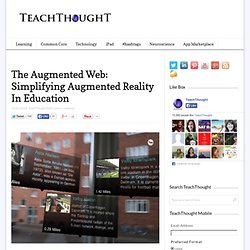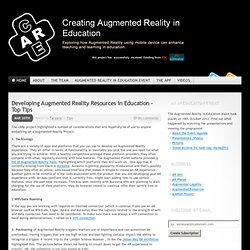

JoyAR Grundtvig partnership website. The Sword of Damocles (virtual reality) The Augmented Web: Simplifying Augmented Reality In Education. The Augmented Web: Simplifying Augmented Reality In Education by Maria Politis, Head of Content and Community at buildAR If you spend time on twitter looking at the #augmentedreality and #edutech hashtags you will know that there is quite a lot of discussion going on about Augmented Reality, and how it can be used as an educational tool.

And with good reason. The web is full of innovative examples of how Augmented Reality is used in classrooms around the world every day. The ability to overlay digital content and information onto the real world, using triggers like images and locations opens up a world of rich learning opportunities. There is a wide range of Augmented Reality applications for the classroom currently available and real, practical uses of the technology are easy to find. Misunderstanding The Complexity Yet there still seems to be a widespread belief that Augmented Reality is difficult to implement. How Does Browser-Based Augmented Reality Work?
Want To Learn More? Creating Augmented Reality for Education. The cARe project explores two examples of how Augmented Reality (AR) could be used to enhance learning.

The examples focus on the use of AR with nursing students. Further details of the projects are described below. You can also watch the video that was used to describe the project. Example 1 – Clinical Skills Laboratory The first of these projects looked at the use of AR in supporting simulated practice. In this example a series of markers were set up around the laboratory. The essential resources were accessed before, after and during practicing a skills enabling students to reflect on their learning (experiential learning), work together (promoting collaborative learning and peer feedback) and at their own pace (self paced learning). To gain some initial student feedback a group of students were filmed as they used the technology and then asked to participate in a focus group. Student Feedback The main insights from the focus group indicated that: Example 2 – Public Health Walk. AR at Digifest14 (with images, tweets) · gingerblox. Immersive Learning Experiences through Augmented Reality.
Author: Judy Bloxham - Jisc RSC Northwest; Allen Crawford-Thomas - Jisc RSC West Midlands; Stephen Wileman - South Staffordshire College What is Augmented Reality?

Augmented Reality overlays the digital world over the physical world - thus ‘augmenting’ the real world experience. Today examples of AR use can be seen in museums where AR is used to bring objects to life or as wearable technology such as the Google Glass project. AR is not a new concept, in fact, it has been around since the 1990’s. Early examples of AR use in mass education made use of QR (Quick Reference) codes. AR and Pedagogy So how does AR relate to learning and what are the pedagogical arguments?
Placing learning into the context to which it is relevant, relates to the concept of situated learning (Johnson, L. et al, 2011). Engaging learners by making use of their own familiar devices can be a powerful motivator, as well as a constructive way to develop ‘Bring Your Own Device’ (BYOD) practice.